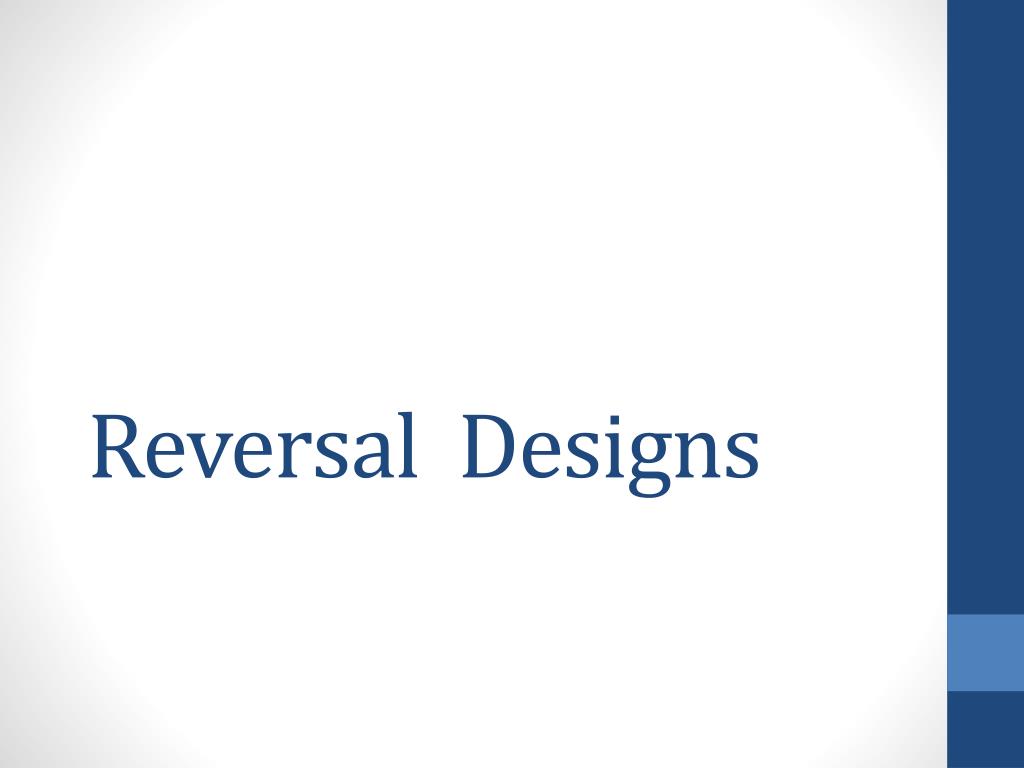Table Of Content
- Memory loss associated with Alzheimer’s reversed for first time
- Reversing The Snip: That Vasectomy Doesn't Mean Children Aren't The Future
- Terahertz chiral subwavelength cavities breaking time-reversal symmetry via ultrastrong light-matter interaction
- Why You Should Consider an Inverted Floor Plan
- 2: Single-Subject Research Designs
- Multiple-Baseline Design Across Participants
- Single-Subject Research Designs

A study method in which the researcher gathers data on a baseline state, introduces the treatment and continues observation until a steady state is reached, and finally removes the treatment and observes the participant until they return to a steady state. While this A-B-A experimental design is well-known, there are many variations (e.g., A-B-A-B or B-A-B) that allow for replication of the baseline and intervention. The A-B-A-B design, such as the graph above, allows for better experimental control and, therefore, is favored.

Memory loss associated with Alzheimer’s reversed for first time
During the baseline phase, they observed the students for 10-minute periods each day during lunch recess and counted the number of aggressive behaviours they exhibited toward their peers. They found that the number of aggressive behaviours exhibited by each student dropped shortly after the program was implemented at his or her school. In one version of the design, a baseline is established for each of several participants, and the treatment is then introduced for each one. The key to this design is that the treatment is introduced at a different time for each participant. The idea is that if the dependent variable changes when the treatment is introduced for one participant, it might be a coincidence. But if the dependent variable changes when the treatment is introduced for multiple participants—especially when the treatment is introduced at different times for the different participants—then it is extremely unlikely to be a coincidence.

Reversing The Snip: That Vasectomy Doesn't Mean Children Aren't The Future
This type of design may be relevant for drugs that have rapid effects with a short half-life and behavioral interventions that have rapid effects (Coyle & Robertson, 1998)—for example, the effects of biofeedback on heart rate (Weems, 1998). Another design is the changing criterion design, in which experimental control is demonstrated when the outcome meets certain preselected criteria that can be systematically increased or decreased over time (Hartmann & Hall, 1976). The design is especially useful when learning a new skill or when outcomes change slowly over time (Singh & Leung, 1988)—for example, gradually increasing the range of foods chosen in a previously highly selective eater (Russo et al., 2019).
In reversal, motorized watercraft will now be allowed at Prospect Lake in Colorado Springs - Colorado Public Radio
In reversal, motorized watercraft will now be allowed at Prospect Lake in Colorado Springs.
Posted: Wed, 09 Mar 2022 08:00:00 GMT [source]
Terahertz chiral subwavelength cavities breaking time-reversal symmetry via ultrastrong light-matter interaction
Or one treatment could be implemented in the morning and another in the afternoon. The alternating treatments design can be a quick and effective way of comparing treatments, but only when the treatments are fast acting. Single-subject research, by contrast, relies heavily on a very different approach called visual inspection.
Why You Should Consider an Inverted Floor Plan
The greater the percentage of non-overlapping data, the stronger the treatment effect. The most basic single-subject research design is the reversal design, also called the ABA design. The mean and standard deviation of each participant’s responses under each condition are computed and compared, and inferential statistical tests such as the t test or analysis of variance are applied (Fisch, 2001)[3]. (Note that averaging across participants is less common.) Another approach is to compute the percentage of non-overlapping data (PND) for each participant (Scruggs & Mastropieri, 2001)[4].
Vasectomy Reversal Expert
SCEDs can be referred to as ‘personalized (N-of-1) trials’ when used this way, but they also have broad applicability to a range of scientific questions. Results from SCEDs can be aggregated using meta-analytic techniques to establish generalizable methods and treatment guidelines (Shadish, 2014; Vannest et al., 2018). Figure 1 presents the main family of SCEDs, and shows how personalized (N-of-1) trials fit into these designs (Vohra et al., 2016). The figure also distinguishes between experimental and nonexperimental single-case designs. In the current article, we provide an overview of SCEDs and thus a context for the articles in this special issue focused on personalized (N-of-1) trials.
2: Single-Subject Research Designs
One solution to these problems is to use a multiple-baseline design, which is represented in Figure 10.4. The key to this design is that the treatment is introduced at a different time for each participant. Single-subject research, by contrast, relies heavily on a very different approach called visual inspection. But if the dependent variable changes when the treatment is introduced for multiple participants—especially when the treatment is introduced at different times for the different participants—then it is unlikely to be a coincidence. Group data are described using statistics such as means, standard deviations, Pearson’s r, and so on to detect general patterns. The multiple baselines can be for different participants, dependent variables, or settings.
Multiple-Baseline Design Across Participants
Perhaps something else happened at about the same time as the treatment—for example, the student’s parents might have started rewarding him for good grades. One solution to these problems is to use a multiple-baseline design, which is represented in Figure 10.3. There are three different types of multiple-baseline designs which we will now consider. In the top panel of Figure 10.5, there are fairly obvious changes in the level and trend of the dependent variable from condition to condition.
In a multiple-treatment reversal designA single-subject research design in which phases that introduce different treatments are alternated., a baseline phase is followed by separate phases in which different treatments are introduced. The participant could then be returned to a baseline phase before reintroducing each treatment—perhaps in the reverse order as a way of controlling for carryover effects. This particular multiple-treatment reversal design could also be referred to as an ABCACB design. Other less commonly used designs within the family of SCEDs may be useful for personalized medicine. While the treatment period may be short, many more replications of treatments—and ineffective treatments—can be identified quickly.
(Note that averaging across participants is less common.) Another approach is to compute the percentage of nonoverlapping data (PND) for each participant (Scruggs & Mastropieri, 2001)[4]. There may be a period of adjustment to the treatment during which the behaviour of interest becomes more variable and begins to increase or decrease. In a multiple-treatment reversal design, a baseline phase is followed by separate phases in which different treatments are introduced. In a multiple-treatment reversal design, a baseline phase is followed by separate phases in which different treatments are introduced.
The most common approach to evaluating the effectiveness of interventions on outcomes is using randomized controlled trials (RCTs). People do not all change at the same rate or in the same way, however; variability in both how people change and the effect of the intervention is inevitable (Fisher et al., 2018; Normand, 2016; Roustit et al., 2018). These sources of variability are conflated in a typical RCT, leading to heterogeneity of treatment effects (HTE).
Since SCEDs rely on repeated measures and a detailed study of the relationship between treatment and outcome, studies that use dependent measures that cannot be sampled frequently are not candidates for SCEDs. Likewise, the failure to identify a temporal relationship between the introduction of treatment and initiation of change in the outcome can make attribution of changes to the intervention challenging. A confounding variable’s association with introduction or removal of the intervention, which may cause inappropriate decisions about the effects of the intervention, is always possible. Dropout or uncontrolled events that occur to individuals can introduce confounding variables to the SCED.
When steady state responding is reached, phase B begins as the researcher introduces the treatment. There may be a period of adjustment to the treatment during which the behavior of interest becomes more variable and begins to increase or decrease. Again, the researcher waits until that dependent variable reaches a steady state so that it is clear whether and how much it has changed. Finally, the researcher removes the treatment and again waits until the dependent variable reaches a steady state. This basic reversal design can also be extended with the reintroduction of the treatment (ABAB), another return to baseline (ABABA), and so on. There are close relatives of the basic reversal design that allow for the evaluation of more than one treatment.
Our hope is that this article will inspire a diverse array of students, engineers, scientists, and practitioners to further explore the utility, rigor, and flexibility of these designs. As an example, consider a study by Scott Ross and Robert Horner (Ross & Horner, 2009)[2]. They found that the number of aggressive behaviors exhibited by each student dropped shortly after the program was implemented at the student’s school. One of them is changes in the level of the dependent variable from condition to condition. A second factor is trend, which refers to gradual increases or decreases in the dependent variable across observations. A third factor is latency, which is the time it takes for the dependent variable to begin changing after a change in conditions.
It can be especially telling when a trend changes directions—for example, when an unwanted behavior is increasing during baseline but then begins to decrease with the introduction of the treatment. A third factor is latencyOne factor that is considered in the visual inspection of single-subject data. The time between the change in conditions and the change in the dependent variable., which is the time it takes for the dependent variable to begin changing after a change in conditions. In general, if a change in the dependent variable begins shortly after a change in conditions, this suggests that the treatment was responsible.
Ideal for sloped lots, reverse living house plans are a great choice for building lots with panoramic views. With a reverse living floor plan often the bedrooms, garage, storage, and other secondary spaces are on the ground or main floor. The social gathering spaces such as the living room, dining room, kitchen, and when space allows the master bedroom are on the upper level.

No comments:
Post a Comment